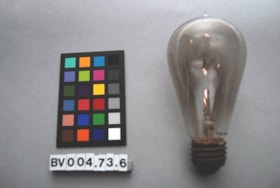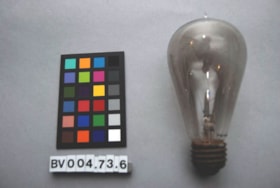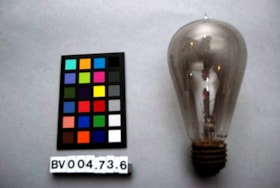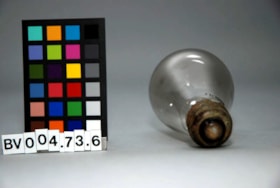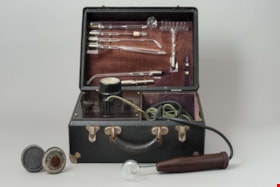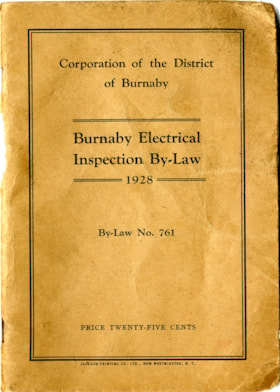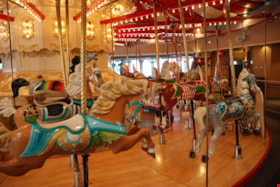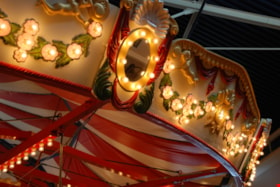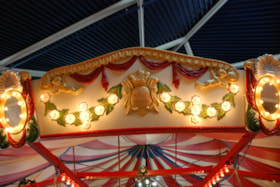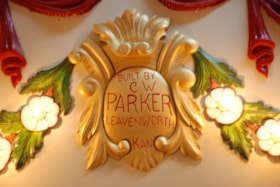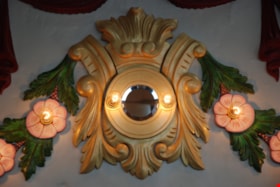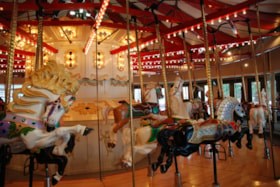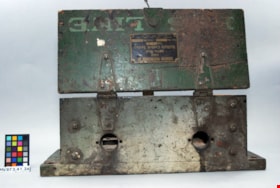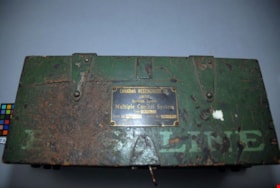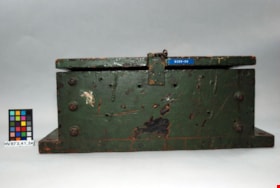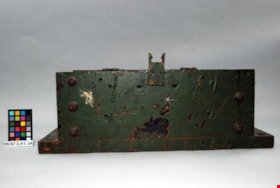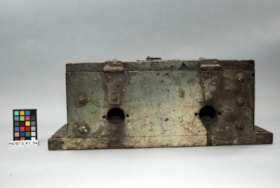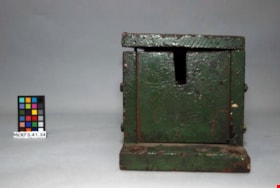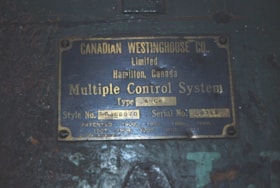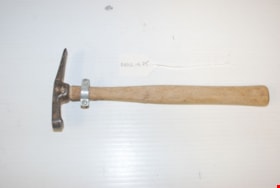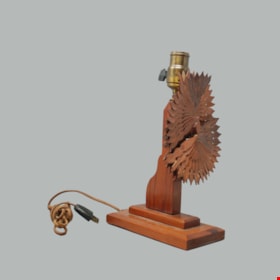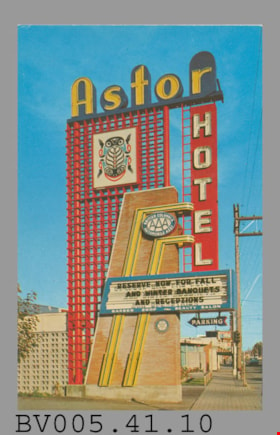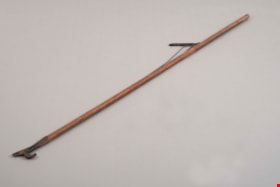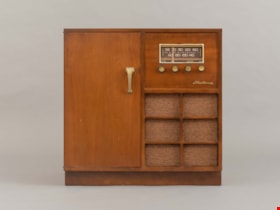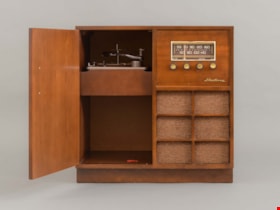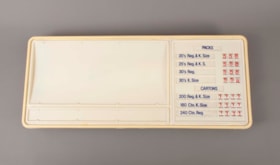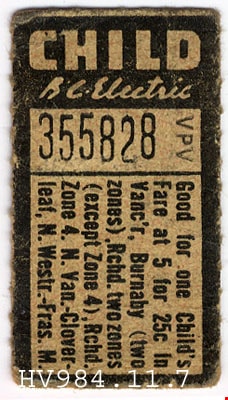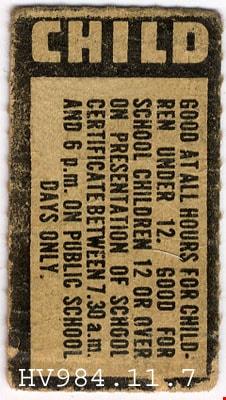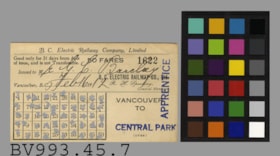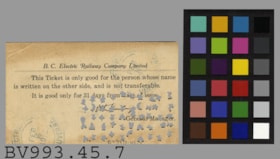Narrow Results By
Subject
- Advertising Medium 14
- Advertising Medium - Signs and Signboards 14
- Agricultural Tools and Equipment - Gardening Equipment 1
- Building Components 1
- Building Components - Windows 1
- Buildings 1
- Buildings - Commercial 1
- Buildings - Commercial - Hotels and Motels 1
- Clothing - Headwear 1
- Clothing - Outerwear 2
- Clothing - Uniforms 3
- Container 3
Person / Organization
- British Columbia Electric Railway Company 93
- Canada Way Food Market 1
- Carson, Norman Thomas "Tom" 3
- City of Burnaby 1
- C.W. Parker Company 2
- Law, Yee "Herbert" 1
- Love Family 1
- Love, George Richard 1
- Lower Mainland Association of the Friends of the Vancouver Carousel 2
- Pacific National Exhibition (PNE) 1
- Philips, Adell Greenwood 1
- Stewart, Hugh Henry 1
insulator
https://search.heritageburnaby.ca/link/museumartifact90821
- Repository
- Burnaby Village Museum
- Accession Code
- BV020.40.12
- Description
- Aquamarine blue insulator with a rounded top and threads visible on the inside. Significantly chipped around the smooth lower edge on the bottom.
- Object History
- This insulator was found during construction around Ceperley Mansion. The property was one of the earliest to have power throughout the whole acreage.
- Category
- 08. Communication Artifacts
- Classification
- Electrical & Magnetic T&E - - Electrical System Components
- Object Term
- Insulator
- Colour
- Blue
- Historic Neighbourhood
- Burnaby Lake (Historic Neighbourhood)
Images
light bulb
https://search.heritageburnaby.ca/link/museumartifact47311
- Repository
- Burnaby Village Museum
- Accession Code
- BV004.73.6
- Description
- Light bulb, "B.C.E.R. Co." stamped faintly near metal base.
- Object History
- Belonged to donor's mother and father.
- Marks/Labels
- "B.C.E.R. Co." stamped faintly near metal base. (British Columbia Electric Railway Company)
- Subjects
- Transportation
- Transportation - Public Transit
- Transportation - Electric Railroads
- Lighting Devices
- Lighting Devices - Light Bulbs
- Electrical and Magnetic Tools and Equipment
Images
violet ray generator kit
https://search.heritageburnaby.ca/link/museumartifact5622
- Repository
- Burnaby Village Museum
- Accession Code
- BV986.20.2
- Description
- Violet ray generator; box is black, silver corners, hinged lid, two hinged snap closures, black handle; inside lid is brown velvet with silver holders for glass tube attachments; plaque "CHAS.A.BRANSTON LIMITED"; in box left side is voltage dial, three black control knobs; right side is compartment for two cords, one with plug end, other with hollow brown bakelite? handle; with two discs on handles, two metal tubes, one roller with handle, metal rectangle, and red instruction booklet "THE BRANSTON VIOLET RAY HIGH FREQUENCY GENERATOR", illustrated; c. 1928
- Object History
- This is a Branston Violet Ray Generator. Branston’s claims were similar to those of other Violet Ray makers. Treatments are given for over a hundred ailments, ranging from abscess through appendicitis, colitis, diabetes, glaucoma, gonorrhoea, haemmorrhoids, impotence, laryngitis, mumps, pyorrhea, tuberculosis, ulcers, wrinkles and even writer’s cramp. Electrical medical devices like this one were popular for decades among physicians, irregular practitioners, and home users, who could purchase them through catalogs and drugstores. The machine plugs into an electrical wall outlet. A glass electrode plugs into the wand, produces a violet glow, and delivers a spark when touched to the skin. The strength of the spark, controlled by the voltage selector, ranges from mild to quite intense. Attachments could stimulate many body parts.
- Classification
- Energy Production T&E - - Other Energy Production T&E
- Object Term
- Generator
- Historic Neighbourhood
- Central Park (Historic Neighbourhood)
- Planning Study Area
- Douglas-Gilpin Area
Images
Early History of the British Columbia Electric Power System
https://search.heritageburnaby.ca/link/archivedescription65650
- Repository
- City of Burnaby Archives
- Date
- March 20, 1936 (date of original)
- Collection/Fonds
- Burnaby Historical Society fonds
- Description Level
- Item
- Physical Description
- 1 programme (photocopied)
- Scope and Content
- Item is a photocopy of a booklet entitled "Early History of The British Columbia Electric Power System in the Lower Mainland of British Columbia" an address given by A. Vilstrup, Chief Electrical Engineer, British Columbia Electric Railway Co. Ltd, before the Vancouver Section of the American Insti…
- Repository
- City of Burnaby Archives
- Date
- March 20, 1936 (date of original)
- Collection/Fonds
- Burnaby Historical Society fonds
- Subseries
- Brian Elder subseries
- Physical Description
- 1 programme (photocopied)
- Description Level
- Item
- Record No.
- 42579
- Accession Number
- BHS1996-23
- Scope and Content
- Item is a photocopy of a booklet entitled "Early History of The British Columbia Electric Power System in the Lower Mainland of British Columbia" an address given by A. Vilstrup, Chief Electrical Engineer, British Columbia Electric Railway Co. Ltd, before the Vancouver Section of the American Institute of Electrical Engineers.
- Media Type
- Textual Record
- Notes
- Continuation of title: "...in the Lower Mainland of British Columbia"
Applications for position of wiring inspector
https://search.heritageburnaby.ca/link/archivedescription1005
- Repository
- City of Burnaby Archives
- Date
- 1915
- Collection/Fonds
- City Council and Office of the City Clerk fonds
- Description Level
- File
- Physical Description
- Textual record
- Scope and Content
- File contains correspondence and formal applications for the position of Electrical Wiring Inspector for the City of Burnaby.
- Repository
- City of Burnaby Archives
- Date
- 1915
- Collection/Fonds
- City Council and Office of the City Clerk fonds
- Physical Description
- Textual record
- Description Level
- File
- Record No.
- 2784
- Accession Number
- 2001-02
- Scope and Content
- File contains correspondence and formal applications for the position of Electrical Wiring Inspector for the City of Burnaby.
- Media Type
- Textual Record
booklet
https://search.heritageburnaby.ca/link/museumartifact20303
- Repository
- Burnaby Village Museum
- Accession Code
- HV977.121.2
- Description
- Booklet titled "Corporation of the District / of Burnaby / Burnaby Electrical / Inspection By-Law / 1928 / By-Law No. 761". Light brown cardstock cover; interior content printed on white cartridge pages; both sides; pages numbered 1 to 46; back page includes index. Two staples at centre for binding.
- Category
- 08. Communication Artifacts
- Classification
- Documentary Artifacts - - Government Records
- Object Term
- Bylaws
- Marks/Labels
- Corporation of the District / of Burnaby / Burnaby Electrical / Inspection By-Law / 1928 / By-Law No. 761 / PRICE TWENTY-FIVE CENTS / JACKSON PRINTING CO. LTD., NEW WESTMINSTER, B. C." printed on front cover
- Colour
- Brown
- Subjects
- Documentary Artifacts - Booklets
- Names
- City of Burnaby
Images
carousel
https://search.heritageburnaby.ca/link/museumartifact71793
- Repository
- Burnaby Village Museum
- Accession Code
- BV993.50.1
- Description
- C.W. Parker Carousel. Hand-carved wooden carousel built in Leavenworth, Kansas in 1912.
- There are 36 wooden horses and 1 chariot plus 4 cast aluminum ponies. The Carousel has 500 major parts, including 14 rounding boards, 14 shields, 52 scenery panels, 140 mirrors, 28 stationary brass poles and 858 11-watt lights.
- Originally the carousel was powered by a steam engine but is now powered by a three-phase electrical motor capable of 5 horsepower. The speed of the carousel is approximately 5 revolutions per minute.
- The carousel is housed in the Don Wrigely Pavilion at the Burnaby Village Museum and is in operation during the museum's open hours.
- Object History
- This carousel was built in 1912 at Leavenworth Kansas by C.W. Parker and was the 119th one made by them.
- It was originally sold in 1913 to Mr. F.K. Leggett of Houston Texas for $5,886.00 and was originally equipped with a steam engine and "wishbones/grass-hopper/jumping horse" mechanisms. It toured Texas for two years with the Lone Star Circus then in 1915 the machine was shipped back to the factory.
- It is believed that the machine was rebuilt by the factory, had some fancier horses and heavier rounding boards added. The jumping mechanism may have been changed then as well.
- Some of the horses are c.1917 and some 1920-22.
- The factory records consulted do not tell for certain where the machine went between 1915 and 1936, possibly to San Jose, CA from 1918 until 1922 and then to San Francisco California, or in Tacoma, Washington.
- In 1936 it was purchased, and was in operation at Happlyland in Vancouver by May 1936. The Parker #119 was put into a pavilion which had been built in 1928 by a rival company (Philadelphia Toboggan Company - P.T.C.) and was located next to the "Shoot the Chutes" ride. Here it remained until Happyland was demolished in 1957. Parker #119 was moved to the new small pavillion in Playland until that too was demolished in 1972.
- From 1972 to 1989, Parker #119 was operated outdoors, and was put away each winter. In 1989 it was announced that the carousel would be sold off horse by horse at an auction in New York. Ms. Venus Solano and Mr. Doug McCalum and other local people came together to "Save the Carousel" and formed the "Friends of the Vancouver Carousel Society".
- In May 1989, Burnaby Village Museum agreed to provide a home for the carousel and the "Friends", led by President Don Wrigley, set about raising the $330,000 to purchase the machine. Keith Jamieson, a carousel expert, was brought in to coordinate the rebuilding project. With a lot of hard work, the help of the Government of British Columbia and the support of the Municipality of Burnaby, the carousel was purchased. Funds were also raised to pay for the restoration, and Burnaby agreed to build a new pavilion for it as a Centennial project.
- Measurements
- Diameter: 2.19 metres (40 feet) at the platform
- Outer circumference: 38.1 metres (125 feet)
- Inner circumference: 23.34 metres
- Height: 8.84 metres (29 feet) at the centre
- Weight: 16 metric tons or 16,000kg empty (14 ½ tons) and 19 metric tons loaded (17 tons). Each horse weighs between 28-37 kg (75-100 pounds).
- Maker
- C. W. Parker Company
- Country Made
- United States of America
- Province Made
- Kansas
- Site/City Made
- Leavenworth
- Subjects
- Recreational Devices - Carousels
- Names
- Pacific National Exhibition (PNE)
- Lower Mainland Association of the Friends of the Vancouver Carousel
- C.W. Parker Company
Images
control box (buss line)
https://search.heritageburnaby.ca/link/museumartifact28958
- Repository
- Burnaby Village Museum
- Accession Code
- HV973.41.34
- Description
- A green wooden box which mounted inside the header of an interurban or streetcar. On the front is a brass plate painted black with "CANADIAN WESTINGHOUSE CO." "Multiple Control System" "Patented 1900 1911". Has a hinged top with a spring loaded clasp at the front bottom. Two flanges extend on both sides of the box with four large holes at each corner for mounting. Five bolts in total (three at one end and two at the end with the slot) extend from the front to the back at each end to hold the box together. A slot is located at one end. At the top are two 4 cm holes allowing for the entrance and exit of electrical cables. Inside are the remains of one of the copper contacts. Length: 50 cm Width: 18 cm Height: 20.1 cm
- Object History
- British Columbia Electric Railway line box "Multiple Control System, West Co."
- Marks/Labels
- "BCER - 58" on blue tape. Metal plate on box lid "CANADIAN WESTINGHOUSE CO. / Limited / Hamilton, Canada / Multiple Control System / Type 496c / Style No.S.O.456070 Serial No. 56713 / PATENTED. 1900, 1902, 1905, 1906 / 1907 1908, 1909, 1910, 1911 / 2709 18-22-1...", etched into the metal plate on box lid. Black background with raised text.
Images
Don McQueen fonds
https://search.heritageburnaby.ca/link/archivedescription88836
- Repository
- City of Burnaby Archives
- Date
- 1961-1964
- Collection/Fonds
- Don McQueen fonds
- Description Level
- Fonds
- Physical Description
- 99 photographs (35 large b&w prints; 36 medium b&w prints; 15 small b&w prints; 5 large b&w panoramas) + 0.5 cm. of textual records.
- Scope and Content
- Fonds consists of a scrapbook organized by Don McQueen containing photographs, newspaper articles, and clippings from the Fraser Valley Milk Producers Association (FVMPA) newsletter "Fraser Valley Milk Break". The scrapbook documents and chronologizes the planning, construction, and implementation …
- Repository
- City of Burnaby Archives
- Date
- 1961-1964
- Collection/Fonds
- Don McQueen fonds
- Physical Description
- 99 photographs (35 large b&w prints; 36 medium b&w prints; 15 small b&w prints; 5 large b&w panoramas) + 0.5 cm. of textual records.
- Description Level
- Fonds
- Access Restriction
- In Archives only
- Reproduction Restriction
- No reproduction permitted
- Accession Number
- 2015-10
- Scope and Content
- Fonds consists of a scrapbook organized by Don McQueen containing photographs, newspaper articles, and clippings from the Fraser Valley Milk Producers Association (FVMPA) newsletter "Fraser Valley Milk Break". The scrapbook documents and chronologizes the planning, construction, and implementation of the FVMPA Plant located on Lougheed Highway in Burnaby as well as providing some background history on this organization.
- History
- Don McQueen was born September 7, 1918, in Wilkie, Saskatchewan, and was the son of Thomas Kerningham McQueen (1873-1948) and Ethel (Badley) McQueen (1889-1981) and brother to Tom Alexander McQueen (1920-1999). In 1924, Don moved with his family from Wilkie, Saskatchewan, to North Vancouver, where they lived until 1930 when they moved to Burnaby. In 1942, Don moved back to North Vancouver, and in 1951, he settled in West Vancouver. As a child, Don attended Queen Mary Elementary School in North Vancouver, followed by attending Burnaby North High School and completing a degree in Engineering at the University of British Columbia in 1948. Don married Rosina Amelia Hewett in 1942 and together they had four children: Donald James (Winnie) McQueen; Rose Anne (Wayne) McQueen; Robin Elaine (Robert) McQueen; and Robert Douglas McQueen. Following the death of Don's first wife, Rosina, in 1966, Don was married three more times, beginning with Laverne Cyr, followed by Marian Schreiber and Gregoria Noble. He had seven grandchildren: Tanja, Mark, Todd, Karina, Morgan, Anthony, and Kosal. During World War II, Don worked at Boeing Air Craft, building planes, and after the war, from 1945 until 1948, he worked at the shipyards in North Vancouver. In 1948, he joined Dairyland, which was affiliated with the Fraser Valley Milk Producers' Association (FVMPA), working as the head of Engineering until his retirement in 1980. Building the FVMPA plant, which opened in 1964, was a highlight of his career, where he was employed as the lead Engineer in creating a state-of-the-art plant located at Lougheed Highway and Sperling Avenue in Burnaby. Don spent three years directing research investigations into modern dairies and ice cream plants throughout Canada and the USA. This plant served the FVMPA for many years to come, and his dedication resulted in giving hundreds of hours of overtime for which he was never paid. The FVPMA was organized by farmers to protect the quality and price of milk. It was granted its charter on June 18th, 1913, and the organization was represented by farmers of every district in the Fraser Valley with 22 locals. In 1919, the Association purchased manufacturing plants and a milk company, and in 1920, the firm acquired another milk company and condensery. In 1923, the FVPMA became the first Canadian dairy organization to establish a quality control laboratory and employ a bacteriologist, and in 1943, the Association established Dairyland dairies. The original headquarters for the FVMPA was located at 425 W. 8th Avenue in Vancouver and as a result of FVMPA's growing success and need for expansion, a modern plant was opened in Burnaby in 1964. The four-million-dollar plant was built on a 24-acre site located at Sperling and Lougheed Highway. This location also housed the association's head office, the Dairyland Fluid Milk Division plant and offices, the Arctic Ice Cream Division plant and offices and the Concentrated Milk Division (Pacific Evaporated and Powder) sales and offices. The facility included a processing plant, service block, garage, primary and secondary mechanical and electrical services, and air conditioned office space. The general contract to build the plant was awarded to John Laing and Son (Canada) Ltd. and was overseen by the FVMPA engineering department, headed by D.R. McQueen, P. Eng. Don belonged to the Association of Professional Engineers and Geoscientists of B.C. (APEGB) from 1948, was a founding member of the Hollyburn Country Club in West Vancouver, and between 1950 and the 1960s, was a director on the board for the West Vancouver YMCA. Don had many hobbies including Russian ballet, kinesiology, drawing, photography, sailing, canoeing, and teaching ballroom dancing and downhill skiing. He competed in fencing in the Empire Games in the 1950s and was slated to canoe for Canada in the 1940 Olympics but was prevented by the war. He was a carpenter and handyman, beginning with building his first sailboat at 12 years of age, and later enjoyed building and restoring furniture. Don passed away on October 22, 2017 at the age of 99.
- Media Type
- Textual Record
- Photograph
- Creator
- McQueen, Don
- Notes
- Title based on contents of fonds
- MSS193, photo catalogue 588
Hammer
https://search.heritageburnaby.ca/link/museumartifact82299
- Repository
- Burnaby Village Museum
- Accession Code
- BV012.14.75
- Description
- A hammer with a oval shaped wooden handle and steel head. One end of the head is square while the other is chisel shaped. An electrical silver coloured clamp is holding the split handle to the head. Markings are not visible.
- Object History
- Hand tools used by John Yanko in his business as a tile setter. Annie D. Basiuk (later Yanko) was born on February 25, 1902 in Sheho, Saskatchewan (formerly Sheho, North West Territories). Daniel "Dan" Yanko was born in Kobilnicha, Ukraine in 1887 and immigrated to Canada in May or June of 1905. Daniel Yanko married Annie D. Basiuk and had thirteen children together. Their son, John Ivan Yanko was born on the family farm, near Kelliher, Saskatchewan, on June 27, 1923. In grade six, John was pulled out of school to help support the family. Eugenia “Jenny” Haresomovych (later Carman) was born August 8, 1904 in Galecia, Austria. She came to Canada in 1928, when her parents sent her to live with the Austrian consular in Halifax. A year later, she was in The Pas with Albert Edward Carman, with whom she would have three children. Their daughter, Leida Doria "Lillian Doris" Carman was born in The Pas, Manitoba March 24, 1929. Eugenia “Jenny” (Haresomovych) Carman later re-married Joseph Nagy who was born in Hungary in October 3, 1900. Jenny, Joseph and the children moved to Nelson, British Columbia, where Joseph worked for the Canadian Pacific Railway. At the age of twenty, John Yanko met his future wife Lillian Doris Carman while visiting relatives in Burnaby. Lillian received a rail pass because of her dad’s employment with the CPR and at fourteen had gone to visit her Godmother in Burnaby. John Ivan Yanko and Leida Doria "Lillian Doris" Carman were married October 16, 1948 in Nelson, British Columbia and moved into the basement of John’s sister’s house on Union Street. Lillian began working at the downtown Woodward’s store as a cashier in 1948. In 1950, the young couple bought property at 7385 (later renumbered 7391) Broadway in Burnaby and began constructing a house as they could afford it. Knowing she’d be let go if she was pregnant, when Lillian was expecting her first child, Jenny sewed her several versions of the same outfit; they all used the same material, but each was a little bit larger than the last to accommodate her expanding girth. Rhonda, born in 1953 and Charmaine, born in 1955, grew up in the Broadway home. They attended school at Sperling Elementary, and later at Burnaby North high school. Lillian left her job to be a stay-at-home mom when Rhonda was born, but that changed in 1963 when John and Charmaine were in a car accident that left John temporarily unable to work. Joseph Nagy died April 20, 1962; his wife Eugenia “Jenny” (Haresomovych) (Carman) Nagy passed away August 14, 1985. Daniel "Dan" Yanko died in 1976; his wife Annie D. (Basiuk) Yanko died in 1997. John Yanko later returned to work, establishing his own tile setting business and working until age eighty-two. John and Lillian lived out the rest of their married lives on the Broadway property. John Ivan Yanko passed away in 2010; his wife Leida Doria "Lillian Doris" Carman (Carman) Yanko passed away in 2011.
- Marks/Labels
- "Marshalltown / NO. 831 TOOL BAG / U.S.A." printed in blue on one side.
- Measurements
- Overall measurement: Length: 28.7 cm Width: 10.3 cm Thickness: 2.5 cm
- Names
- Yanko, John Ivan
- Yanko Family
Images
Jesse Love farmhouse series
https://search.heritageburnaby.ca/link/museumdescription9782
- Repository
- Burnaby Village Museum
- Date
- [1893-1970] (date of originals), copied 1988-1998, predominant 1988-2000
- Collection/Fonds
- Burnaby Village Museum fonds
- Description Level
- Series
- Physical Description
- approx. 84 cm of textual records + approx. 1,910 photographs + approx. 100 architectural drawings + 3 audio cassettes + 1 videocassette
- Scope and Content
- Series consists of records involved in the purchase, moving, restoration, research, conservation and exhibiting of the Love family farmhouse by Burnaby Village Museum. Records have been arranged into the following subseries: 1) Love farmhouse conservation work files subseries 2) Love farmhouse re…
- Repository
- Burnaby Village Museum
- Collection/Fonds
- Burnaby Village Museum fonds
- Series
- Jesse Love farmhouse series
- Description Level
- Series
- Physical Description
- approx. 84 cm of textual records + approx. 1,910 photographs + approx. 100 architectural drawings + 3 audio cassettes + 1 videocassette
- Scope and Content
- Series consists of records involved in the purchase, moving, restoration, research, conservation and exhibiting of the Love family farmhouse by Burnaby Village Museum. Records have been arranged into the following subseries: 1) Love farmhouse conservation work files subseries 2) Love farmhouse restoration photographs subseries 3) Love farmhouse curatorial files subseries 4) Love farmouse research files subseries 5) Love family photographs 6) Love farmhouse Oral History subseries 7) Love farmhouse architectural drawings subseries
- History
- Jesse Love was born in Swindon, England in 1847 and left England to work on a dairy farm in the Toronto area. While working on the farm in Toronto, he met Martha Leonard who he married in 1879. Martha was born on February 3, 1858 in Bedfordshire, England and had come to Canada with her parents George and Ann Leonard. While living in Toronto, Jesse and Martha had two children, George born March 22, 1880 and Annie Elizabeth on August 24, 1881. About one year after Annie was born, the Love family moved to North Dakota to grow wheat. While living there, they had two more children, Henry who was born August 24, 1883 and Edith Minnie born October 9, 1885. The family decided to move further west after hearing about the fairer weather conditions from Martha’s father, George Leonard, who had settled in Vancouver in 1885. On May 23, 1887, Jesse, Martha and their four children arrived in Vancouver after travelling across Canada from Winnipeg on the first transcontinental train. The Loves made their home in Vancouver while Jesse helped clear land on Granville Street. Their fifth child, Thomas Robert was born on September 17, 1887 and soon after, the family moved to Lulu Island in Richmond where they lived growing vegetables and selling them to Vancouver hotels. While living and farming on Lulu island, the couple had two more girls, Martha (Dot or Dorothy) born on December 17, 1889 and Sarah Marie, born February 8, 1892. On October 6, 1893 an agreement was signed by Jesse Love to purchase 14.52 acres of land from Joseph C. Armstrong. The acreage covered the north east section of District Lot 25 within the newly incorporated District of the Municipality of Burnaby. It was here where the original Love house was built (between October 1893 and April 15, 1894) by Jesse Love with the help of local builder George Salt and father in law, George Leonard. The house consisted of an entrance hall, dining room, lean to kitchen, master bedroom and three bedrooms upstairs. A road was constructed and named Cumberland in 1905 and ran from District Lot 25 through to District Lot 11. The address for the Love home was 1390 Cumberland Road and in the early 1960’s the address was renumbered 7651 Cumberland Street. On the land surrounding the house, Jesse Love planted an orchard along with strawberries and raspberries which he sold at the Fraser Valley Market, T.S. Anandale’s Grocery Store in New Westminster and to hotels around Vancouver. Jesse Love served on the Burnaby School Board and also as a District Councillor in 1901 and from 1904-1907. While living in the house, Jesse and Martha had four more children, Phoebe Leonard, born April 15, 1894, Esther, born August 28, 1896, John Leonard, born June 7, 1899 and Hannah Victoria (also known as Girlie) who was born May 12, 1902. As the family grew to eleven children, additions along with some substantial remodelling in the craftsman style took place. In about 1898, a north wing addition was added to include a parlour with two windows, the construction of two more bedrooms and the relocation of the stair case to the North West wall. In 1903 the front door moved to the north elevation, a front porch was extended along the east wall and a summer lean to kitchen was added to the west elevation. Between 1905 and 1910, a tin embossed ceiling was installed along with an addition of the main kitchen which included a pantry, bathtub and a back porch. In about 1912, five craftsman style windows replaced the original pioneer tent style, the front verandah was enlarged to wrap around the south and east elevations, a back door was installed in the kitchen to access the verandah and wood shingle siding and brackets were added to the exterior. In 1918, at the age of 31 years, Robert Love fell ill due to an influenza epidemic and died on November 23, 1918. Following their son’s death, Martha Love became weak and on August 24, 1920, she passed away. By this time, Jesse had sold off a large percentage of his land and his youngest daughter, Girlie decided to stay on to live and care for him. Since the house was too large for just the two of them, Jesse invited any other children to return and share the residence. For a while his son, George and his wife joined them until 1925, followed by his daughter Sarah Parker (nee Love), her husband William and their three children, Albert, Bill and Elsie. The house remained pretty unchanged until 1928 after Jesse Love died of pneumonia (March 10, 1928) and the house was purchased by Sarah and her husband William Parker who continued to live there with their children. The master bedroom wall on the main floor opened up to the dining room, the kitchen pantry and bathtub converted to an alcove with a marble counter and enlarged window and sink while the bathroom was moved to the upstairs and the furnace and coolers were installed in the crawl space under the kitchen. A hot water tank was installed in the house in 1966. Sarah continued to live in the house until a little while after her husband William died in 1961. She sold the house to her daughter Elsie and husband John Hughes in 1966, who lived in the house along with their son Brent, until August 23, 1971. Mahbir Molchan Papan and his wife Geraldine Papan bought the house August 23, 1971 and by 1982, the house was sold to Nirmal Singh Singha and Narinder Singha. The Papans continued to rent the house from Nirmal Singh Singha and Narinder Singha until the late 1980s. In 1988, the house was scheduled for demolition with the remaining property to be subdivided. Fortunately, a neighbour, Mr. Harvey Elder recognized the farmhouse's historical significance and contacted the Burnaby Historical Society. Following this event, the owners agreed to donate the building to the Burnaby Village Museum (under the Century Park Museum Association) who financed the move of the house from Cumberland Street to the museum site. Heritage planner and architect, Robert Lemon provided guidance for the project. Prior to the move, the two porches were removed and demolished while the kitchen and roof were both separated from the main house. The kitchen and roof of the house were transported to Burnaby Village Museum on May 20, 1988 by Nickel Bros. House Moving company, while the main frame of the house completed its transportation to the museum near the end of May 1988 (due to low overhead wires). The house was moved down Cumberland Street to 10th Avenue, up Canada Way to Sperling and set on temporary footings near Hart House. Robert Lemon oversaw structural improvements such as, upgrading floor joists and creating new foundations to replace the original timber foundation of the farmhouse. The restoration went through several phases of work between 1988 until it opened in November 1998. Restoration began on both the interior and exterior features to be interpreted from the period of 1925. On November 23, 1992, the building was designated a heritage building under Heritage Designation Bylaw 1992, Bylaw Number 9807. In 1993, the architecture firm of Brian G. Hart Associates was appointed for the design and construction supervision of the restoration project. Plans were created for a foundation on the museum site in 1989 and the farmhouse was eventually settled on a permanent foundation behind the Burnaby Village Museum administration building in 1993 along with the reattachment of the roof. The kitchen section was reattached to the main house in 1994 along with skirting around the foundation and the reshingling of the exterior. In 1996, the tin ceiling was removed to make way for the installation of the internal electrical system along with sprinklers, ceiling heating and fire break gyprock. The dining room ceiling joists were consolidated, a pantry and bathroom were added to the kitchen, the downstairs bedroom wall was opened and filled, the dining and kitchen doorways were widened. In 1997, a wheelchair ramp was installed along with a concrete sidewalk, stair rails, cement pads at the base of the stairs and a gravel sink for any excess water. Interior work included painting of the kitchen, restoration and furnishing of the kitchen pantry, insulation of the house floor to protect from rodents along with the reconstruction of the kitchen and house chimneys. The registrar worked together with the curator and conservator and was tasked with a large research project on the house including the family contacts and family history, property information, plans, photographs, artifacts, furnishings, stories etc. all organized in files for easy retrieval. A great deal of research and conservation was undertaken in order to make the interior of the house authentic to the time period as possible. One of the biggest projects was selecting and obtaining wall coverings since much of the original wallpaper was incomplete and poor condition. The conservator and registrar were lucky enough to locate a few samples of the original paper and engage the Bradbury and Bradbury Art Wallpaper Company of Benica, California to reproduce replica designs for free. The City of Burnaby now has its own series “Burnaby Village Papers” produced by this company which are titled “Burnaby Wall”; “Burnaby Border” and “Burnaby Ceiling”. All three of these wallpaper designs have been used in the Love farm house and are also commercially available through the Bradbury and Bradbury Art Wallpaper Company. In 1997, restoration of the kitchen was completed and opened to the public. After the completion of the dining room, main floor bedroom and parlour, the Love farmhouse exhibit opened on November 29, 1998 with an open invitation to the public and extended members of the Love family. Officials including the Mayor, Doug Drummond and Love family members were all present to cut the ribbon for the special event.
- Accession Code
- BV018.41; BV020.5
- Access Restriction
- Restricted access
- Date
- [1893-1970] (date of originals), copied 1988-1998, predominant 1988-2000
- Arrangement
- The majority of the records within series and subseries were arranged by a staff members of Burnaby Village Museum who worked on the historical research and restoration of the house. Other photographs documenting the move and further restoration work were added later and included in the arrangment by format and subject.
- Notes
- Title based on content of series
- Jesse Love farmhouse is described as an Artifact under BV988.33.1
- Some records within this collection have restricted access and are subject to FIPPA
- Accessions BV018.41 and BV020.5 form this fonds
lamp
https://search.heritageburnaby.ca/link/museumartifact38604
- Repository
- Burnaby Village Museum
- Accession Code
- BV997.45.1
- Description
- Lamp, wooden, handcrafted; may be made from a single piece of wood; carved wooden fan above base; electrical cord attached to back; no shade.
- Object History
- This lamp was given to Annie Love (daughter of Jesse and Martha Love) by her brother George Love (the oldest son of Jesse and Martha) as a wedding gift for her 1902 marriage to Wallace "Flash" Whiting. George Love owned his own sash and door company. The lamp was hand made by George Love from one solid piece of wood.
- Subjects
- Lighting Devices
Images
postcard
https://search.heritageburnaby.ca/link/museumartifact48616
- Repository
- Burnaby Village Museum
- Accession Code
- BV005.41.10
- Description
- Postcard: colour photo; vertical; "Astor Hotel" neon sign against blue sky; red grid with coloured aboriginal animal logo, yellow-on-blue "Astor" horizontally across top, white-on-red "HOTEL" vertically down right side; brick base with angled left side has two yellow stripes which follow slant then change to horizontal, becoming supports for sign; blue-bordered white message sign at lower part, white "BARBER SHOP" "BEAUTY SALON"; black message lettering "RESERVE NOW FOR FALL AND WINTER BANQUETS AND RECEPTIONS"; black arrow suspended from bottom, points left, white "PARKING"; sidewalk, buildings behind, electrical wire support pole, other signs; on reverse in light blue "ASTOR HOTEL - 3985 Kingsway Ave., Burnaby, B.C." "Deluxe guest rooms with T.V. -- Haida Dining Room -- Coffee Lounge -- Banquet Facilities -- Member Diners Club." "Phone: HE. 3-0551"; up centre, "MADE IN CANADA BY GRANT-MANN LITHOGRAPHERS LTD. COLOR CARD DIVISION, VANCOUVER, BRITISH COLUMBIA."; at bottom, "C-135"; at top, "POST CARD" "ADDRESS"; outline of rectangle at upper right, "STAMP"; pencilled "$7" at upper left; lightly soiled, corners worn; unused
- Classification
- Written Communication T&E - - Writing Media
- Object Term
- Postcard
- Marks/Labels
- Astor / Hotel / Reserve Now for Fall and.. / Astor Hotel. 3985 Kingsway Ave., / Burnaby, B.C. / Deluxe guest rooms
- Country Made
- Canada
- Province Made
- British Columbia
- Site/City Made
- Vancouver
- Title
- Astor Hotel C-135
- Subjects
- Documentary Artifacts
- Documentary Artifacts - Postcards
- Buildings
- Buildings - Commercial
- Buildings - Commercial - Hotels and Motels
Images
pruner
https://search.heritageburnaby.ca/link/museumartifact91748
- Repository
- Burnaby Village Museum
- Accession Code
- BV023.12.3
- Description
- Tree pruner or pruning tool with a hook and restractable blade. There is a metal spring action lever one quarter of the way up the shaft attached to a metal rod that runs the remaining length of the shaft up to the blade. The rod is anchored to the shaft in two places. Pulling the lever engages the blade and exposes
- The lever is wrapped in black electrical tape. The metal parts of the pruner are rusted.
- Object History
- These tools belonged to donor's father who had a market garden at his home on 4930 Marine Drive from 1971-79. Her father's name was Yee Law (or Herbert Law). After Yee stopped farming for a living in 1980, he gave these tools to the his daughter Gail and her family (the Yips). They presume that he no longer needed them. He maintained a 1 acre garden on his property until he couldn't anymore.
- Classification
- Maintenance T&E - - Groundskeeping Equipment
- Object Term
- Pruner, Tree
- Measurements
- Length: 194 cm
- Names
- Law, Yee "Herbert"
- Geographic Access
- Marine Drive
- Street Address
- 4930 Marine Drive
Images
record player
https://search.heritageburnaby.ca/link/museumartifact91557
- Repository
- Burnaby Village Museum
- Accession Code
- BV022.11.1
- Description
- Fleetwood brand radio and record player cabinet. The wooden cabinet has a cabinet door on one side and a control panel and speaker on the other.
- Inside the cabinet is a shelf that holds the record turntable. The turntable has a plastic arm. The shelf below the turntable would be suitable for storing records.
- The control panel includes four knobs for Off-Tone, Volume, Phono-Radio, and Tuning. The panel also includes a dial for AM radio tuning.
- The speaker below has a four paned panel with speaker fabric in a brown tone.
- The back of the cabinet is open on one side to reveal the radio mechanism and speaker.
- The radio has a product stamp from Electrical Products Manufacturing of Montreal, Quebec.
- Vols 115, Model 43-52, Amps 0.45, Cycle 6.0, Serial 31-1
- Object History
- The record player belonged to Adell Philips and was in her Spruce Street home in Burnaby for more than 50 years.
- Classification
- Sound Communication T&E - - Sound Communication Devices
- Object Term
- Player, Record
- Measurements
- Height: 76.5 cm Width: 76.5 cm Depth: 39.5 cm
- Names
- Philips, Adell Greenwood
Images
Riverway West School Parent-Teachers Association subseries
https://search.heritageburnaby.ca/link/archivedescription110
- Repository
- City of Burnaby Archives
- Date
- 1923-1967
- Collection/Fonds
- Burnaby Historical Society fonds
- Description Level
- Subseries
- Physical Description
- 1 scrapbook.
- Scope and Content
- Subseries consists of a Riverway West School PTA scrapbook and photographs.
- Repository
- City of Burnaby Archives
- Date
- 1923-1967
- Collection/Fonds
- Burnaby Historical Society fonds
- Physical Description
- 1 scrapbook.
- Description Level
- Subseries
- Accession Number
- BHS1992-03
- Scope and Content
- Subseries consists of a Riverway West School PTA scrapbook and photographs.
- History
- The original Riverway West School was a one room school house built in 1923 just west of the ravine at Sussex Avenue and Marine Drive. Miss Marion Swanson was the first teacher at the school ande Mr. Morrison its first custodian. Miss Carrie Kidd taught from 1924 to 1935, with the enrolment increasing from 18 in 1924 to 42 pupils in 1929, and including grades one to seven. In 1930 grades one to four were at Riverway while the older students went to Nelson. It continued on as a one-room school of four grades until 1952. As the school was seen by parents to be “greatly lacking” for students and teachers “in comfortable accommodations and vital equipment necessary for their extra curricular and recreational needs, such as were enjoyed by children in the larger schools” they formed a parent-teacher association in September 1951 to remedy the situation. From the beginning the PTA was very active in making its desires known to the School Board and “the school was very fortunate to have an organisation which put forth such a united effort on behalf of the children”. Their first bazaar fundraiser allowed the PTA to purchase a hot plate and the necessary utensils to provide the students with soup and cocoa during the cold weather. At their request, the School Board improved the electrical wiring in the school and built a roof over the stairs to the basement and provided more sports equipment for the children. Art classes and piano classes were started through the efforts of the members and in 1953 a cub pack and a brownie pack with PTA members as Cub Leaders and Brownie Leaders was created. A ditto machine and school library were the direct results of successful bazaars held by the PTA. The PTA also made a survey of the school district in 1951 to analyse the future school population and presented the results to the School Board. Following this, a portable unit was erected beside the existing school house for use the following September. It was in use until 1958. In the late 1950s, the PTA approached the School Board and the Burnaby Parks and Recreation Commission and proposed a park on the grounds adjacent to their school to relieve a playfield deficiency. The creation of Riverway West Park was the direct result of this proposal. As Parks Planner Paul Stocksted pointed out in 1961, “All of this would not have been possible had not the people associated with the PTA insisted on the solution to the problem of inadequate play areas.” In 1957 the first unit of the new Riverway West School underwent construction. Designed by Carlberg and Jackson with Remigio Maniaga as the contractor, it was completed in September of 1957 and consisted of four classrooms, an activity room and administration facilities. A two classroom addition, also designed by Carlberg and Jackson. was completed on the last day of 1959, three months after its construction began.
- Media Type
- Textual Record
- Photograph
- Notes
- PC273, MSS068
- Title based on creator and contents of subseries
sign
https://search.heritageburnaby.ca/link/museumartifact91783
- Repository
- Burnaby Village Museum
- Accession Code
- BV023.17.3
- Description
- Large plastic sign with internal backlighting for advertising. The sign has two sections for ad inserts and one section for price display.
- The price display is currently set up advertising the price of packs and cartons of cigarettes
- The first bank of prices are 3 digit with small windows that reveal the number on a roller behind. The second bank of prices are 4 digits.
- The sign was made by CDA Industries in Scarborough, Ontario and is stamped with "JULY 1986"
- There are three labels at the top of the sign including information about how to replace the lamps or reinsert unrolled numbers.
- There is a hole at the top of the sign for the electrical cord to come out.
- There are two white metal brackets attached to the ends of the sign and there is a rusted chain hanging from each bracket.
- The plastic at the bottom right corner on the back is broken and damaged.
- Object History
- Item was used in the Canada Way Food Market owned by Harry Toy between 1975 and the late 2000s. the building sat vacant until sold in 2023.
- See BV023.25.1 for photograph of sign in situ.
- Category
- 08. Communication Artifacts
- Classification
- Advertising Media
- Object Term
- Sign, Advertising
- Marks/Labels
- "PACKS / 20's Reg. & K. Size 5.58 / 25's Reg. & K.S. 5.58 / 30's Reg. 5.58 / 30's K. Size 5.58"
- "CARTONS / 200 Reg. & K.Size 11.11 / 180 Ctn. K. Size 11.11 / 240 Ctn. Reg. 11.11"
- Measurements
- Height: 57.5 cm
- Width: 133.5 cm
- Depth: 13 cm
- Names
- Canada Way Food Market
- Geographic Access
- Canada Way
- Street Address
- 4692 Canada Way
Images
Waplington family fonds
https://search.heritageburnaby.ca/link/museumdescription4613
- Repository
- Burnaby Village Museum
- Date
- 1911-2004
- Collection/Fonds
- Waplington family fonds
- Description Level
- Fonds
- Physical Description
- 1 album (88 photographs + textual records) + 2 photographs in frames
- Scope and Content
- Fonds consists of records documenting the lives of both the Waplington and Fleming families who resided at 3813 Deer Lake. Records include a family photograph album; two framed portraits: one of John Waplington and Doris Waplington (nee Caswell) (possibly on their wedding day) and Frances (nee Wapl…
- Repository
- Burnaby Village Museum
- Collection/Fonds
- Waplington family fonds
- Description Level
- Fonds
- Physical Description
- 1 album (88 photographs + textual records) + 2 photographs in frames
- Scope and Content
- Fonds consists of records documenting the lives of both the Waplington and Fleming families who resided at 3813 Deer Lake. Records include a family photograph album; two framed portraits: one of John Waplington and Doris Waplington (nee Caswell) (possibly on their wedding day) and Frances (nee Waplington) and Ray Fleming; a copy of a handwritten memoir "The Way it Was / 1913-1925"; as well as a computer printed copy of "In and Out of / A Cedar Shake Shack" / "The life of a little girl from World War I / to Canada's Diamond Jubilee" both written by Frances L. Fleming (nee Waplington). Fonds is arranged into series: 1) Waplington and Fleming families album series 2) Frances Fleming manuscripts series 3) Waplington family documents series 4) Waplington family photographs series
- History
- John (Jack) Waplington emigrated from Nottingham, England in 1904, arriving in Quebec City and continuing on to Ontario before eventually settling in British Columbia. Somewhere on his journey his right hand was crushed in an industrial accident and amputated. Following his recovery, Jack continued to work his way across Canada until he found employment at Stave Falls, B.C. and married Sarah Alice Cogswell (nee Nickerson). Jack and Sarah (nicknamed Cutie) Waplington had three children; Frances Louise Waplington (1913-2004), John Hazen Waplington and Grace Bancroft Waplington. In 1916, the Waplingtons rented the Walker house at Hill Station on the Burnaby Lake Interurban Line and in 1920 Jack built a cedar shack on 5 acres of land at 4925 Douglas Road (northwest corner of Douglas and Laurel). According to a memoir by Frances Waplington, life was rough living in the cedar shack on Douglas Road with no electricity or running water and by 1925 the family was lucky to purchase "Brookfield", the former home of Louis Claude Hill located at 3813 Deer Lake Avenue. The home was not in good shape having been empty for some time but was located on ¾ of an acre and purchased at a fair price of $1000. The house was surrounded by grass and flowers gone wild and very tall fir trees. The house had running water, electricity and was heated by a wood burning stove in the kitchen and hall and a fireplace in the living room. There was no refrigeration other than the ice box. The three Waplington children, Frances, John and Grace continued to attend Douglas Road School. The family renovated and restored the house at Deer Lake as well as the grounds, adding in flower and vegetable gardens. The large area of grass which formerly housed a tennis court was rolled flat and reseeded. Jack Waplington continued to work for the power company which became B.C. Electric Company and eventually B.C. Power and Hydro. The Waplingtons continued to live at 3813 Deer Lake until 1946 when they sold their home to their daughter Frances who married Ray Fleming. Jack and Sarah Waplington retired and moved to Lasquiti island. Frances "Fanny" Waplington married Reyland "Ray" Fleming October 11, 1935. Ray and Frances Fleming had three children; John (Jack) Reyland, Edith (Edie) Louise and Sara Maureen. In 1941 Ray was hired by the B.C. Electric Company to work at Buntzen Lake hydro station. There was no housing at the hydro station so the family lived on a 42’ coastal boat, the Cohoe Bay tied up to the dock at Buntzen Lake. Since it was war time, there was fear that the two hydro plants at Stave Falls and Buntzen Lake could be targeted for bombing so the Fleming family had to learn about air raid sirens, bunkers, helmets and gas masks. The children attended a one room classroom at Buntzen Lake and participated in school drills when the air raid siren sounded. By 1947 the Fleming family moved to the Waplington home at 3813 Deer lake Avenue after purchasing it from Frances’ parents. Ray continued to work for B.C. Electric and eventually B.C. Power and B.C. Hydro. The children walked or rode bicycles to and from Douglas Road School. At the time the family moved into their home there were no buses only the Interurban streetcar to take them to Vancouver. Douglas Road station was the nearest stop to Deer Lake on the Burnaby Lake Line. The closest neighbours were the Oakalla Prison farm (located off of Royal Oak hill overlooking Deer Lake) and the Ceperley mansion. Prison breaks were common and both the Waplington and Fleming families would often hear air raid sirens blare to warn them. The neighbourhood would go on high alert and the children would immediately run home to safety. Mr. Fleming was well prepared with his 22 rifle nearby should it be needed. After Sarah Waplington died, Jack Waplington returned to Deer Lake to live in a house trailer on the property that was owned by the Flemings. In 1959, after the Fleming children had grown and moved on, Ray and Frances Fleming sold the property to the Municipality of Burnaby. The Municipality rented it out for several years prior to its demolition around 1970 to make way for Burnaby’s Heritage Village. Frances Louise Fleming received her teaching degree from the Vancouver Normal School at the end of World War II but found it extremely difficult to secure a permanent teaching position as a woman. Between 1944 and 1954, Frances was hired and fired eight times from teaching positions despite excellent reports. Finally in 1954, she was invited to teach in an adjoining district with a permanent teaching appointment to follow. Over the years, Frances taught in Vancouver, Burnaby, Pender Harbour and served as vice principal at Magee Secondary. In the early 1970s Frances was appointed provincial superintendent of schools at Quesnel and then moved to Victoria to be assistant superintendent of integrated and supportive services and then in 1973, she became assistant superintendent of the department of public intstruction. Frances retired from teaching soon after, moving to the Sunshine Coast with her husband Ray. Frances was awarded the Order of British Columbia in 1997, was an accomplished writer who regularly contributed articles to the Vancouver Sun newspaper and othe publications. Ray Fleming died in 2002 and Frances Fleming died in 2004.
- Accession Code
- BV016.46
- Date
- 1911-2004
- Media Type
- Photograph
- Textual Record
- Arrangement
- Series arrangement is based on physical arrangement of records by donor. Family album was scanned in it's original order and items from within family album were removed and described at item and file level.
- Notes
- Title based on content of fonds
interurban ticket
https://search.heritageburnaby.ca/link/museumartifact14342
- Repository
- Burnaby Village Museum
- Accession Code
- HV984.11.7
- Description
- B.C. Electric - Ticket. Black and white child ticket for the B.C. Electric Railway. The top of the ticket has "CHILD/ B.C. Electric", "355828 VPV". The ticket states the various regulations on both the front and the reverse.
- Subjects
- Exchange Medium
- Exchange Medium - Tickets
- Transportation
- Transportation - Electric Railroads
- Transportation - Public Transit
Images
interurban ticket
https://search.heritageburnaby.ca/link/museumartifact35492
- Repository
- Burnaby Village Museum
- Accession Code
- BV993.45.7
- Description
- B.C. Electric Railway - Ticket; Pass -- [1912]. Punch card ticket for the British Columbia Electric Railway Company from Vancouver to Central Park. The ticket pass was good for 50 fares during 31 days from the date of issue. The ticket was non-transferable and was issues to G.C. Barclay on February 16, 1912. On the left side of the ticket is a grid from 1 to 50. Each square in the grid has been punched with various shapes. The ticket was also stamped with "Central Park" and "Apprentice". On the back of the ticket, it restates the rules and regulations of the pass. The back has also been stamped twice with a round stamp that says "B.C. Electric Railway Vancouver, B.C./ Feb/16/1912". The ticket measures 10.5cm x 6cm.
- Colour
- White
- Country Made
- Canada
- Province Made
- British Columbia
- Site/City Made
- Vancouver
- Subjects
- Exchange Medium
- Exchange Medium - Tickets
- Transportation
- Transportation - Electric Railroads

